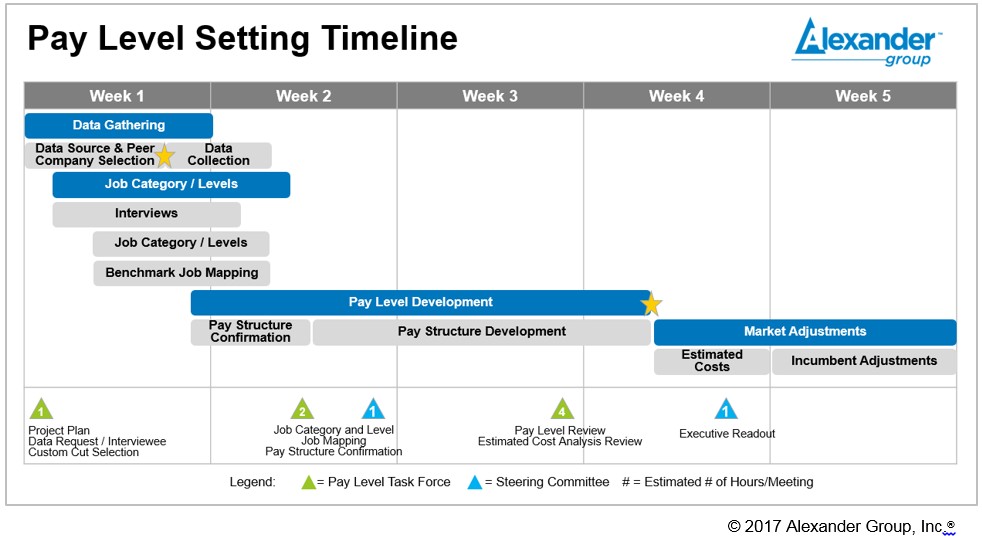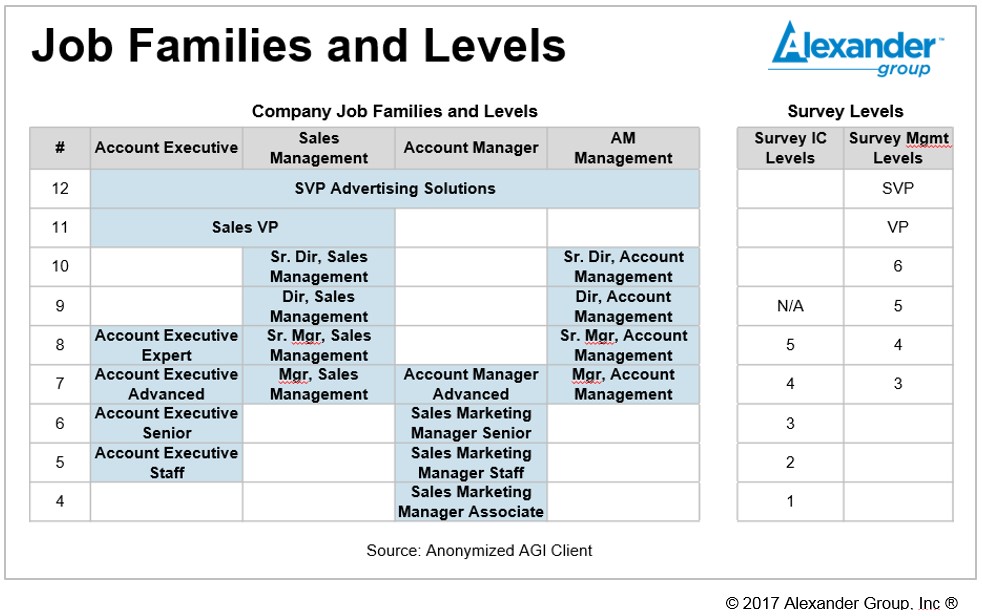Setting Target Total Compensation Levels: A Digital Media/SaaS Company Story
The art of pricing sales jobs begins with benchmarking target total compensation to market data. Companies should follow a best-in-class process to set and manage their pay structures.
Setting new sales job pay structures can take one to two months depending on the number of jobs and incumbents. For many companies, following a typical best practices process may suffice (see Graphic A below). But what if a company faces more challenging data situations? A recent Alexander Group engagement with a digital media ad sales and SaaS client offers clues for managing complex pay structures.
Graphic A
First, gather all current data and job information. Research available survey sources and select most appropriate sources. Select a custom cut of data.
Client Issue: Digital Ad Sale Company just launched a SaaS solution. What data set should they use?
Client Solution: We selected two separate custom data cuts to allow us to understand how each market pays: 1) set of digital media ad sales companies and 2) set of SaaS companies that sell to sales and marketing organizations.
Client Issue: Limited data in some countries.
Client Solution: Compared market variance between custom cut data with general software industry cut in countries with high n-counts. Then, applied that variance to general software cut in countries with low n-counts.
Job Categories/Levels
Interview sales leaders to clarify job content for more accurate job mapping. Make sure to ask questions around internal job equity when accurate job matches are not available. Articulate job levels by job family and map to survey levels (see Graphic B). This structure provides the basis for creating the new pay levels.
Client Issue: Inadequate job matches for many jobs. For example, survey source had a sales representative job, but client had separate hunters and farmers. Also, survey source did not have a good “Digital Media Account Manager” role.
Client Solution: Compared market variance between hunter and farmers in the general software cut and then applied that variance to Digital Media roles. Leveraged a similar role used in the software industry and applied it to Digital Media.
Graphic B
Clarify pay philosophy and pay structure practices. Then, create an excel workbook and gather all the market data to set a pay structure for each job/level for each country.
Client Issue: Must look at multiple data sources and jobs to set structure for each job. In addition, needed to apply variance ratios to many jobs. Lastly, some market data was suspect (e.g., higher job levels paid lower and big pay jumps between levels).
Client Solution: Create a robust excel workbook. Create a tab for each job family and pull in all data sources (industry cut, jobs and levels). This meant pulling 20+ rows of data. Although company mapped to 50th percentile, pull in multiple percentiles (e.g., 25th, 50th, and 75th). Calculate ratios to the side. Graphically display all data in a stock chart to visualize and synthesize the full view. Leverage all data inputs to set new pay structures within each job family tab.
Market Adjustments
Once complete, analyze comp-ratios for each incumbent. If there is a need to make market adjustments, set a market adjustment budget for each leader to use to make adjustments. Set market adjustment budgets by analyzing two scenarios: 1) Move all incumbents who are below the minimum of the range to the minimum point of the new structure. 2) Move all incumbents who are below the minimum of the range to the mid-point of the new structure. Then, set a budget between those two points. HR comp should work closely with sales leaders and their HR business partners to review each individual’s situation and make market adjustment based on employee performance and value to the firm.
Client Problem: Market corrections were expensive. Must obtain executive buy-off on the budget impact.
Client Solution: We leveraged AGI’s COS benchmark database and turnover/ramping employee costs to justify the market adjustment costs.
Conclusion
Analyzing market data to develop pay structures is not always a straightforward exercise. Sophisticated sales compensation professionals should be able to triangulate across multiple data elements to drive sound pay level decisions that attract and retain the right talent for their company.
How the Alexander Group Can Help
If you need help setting your Target Total Compensation levels or any other sales compensation plan design question, please contact us at the Alexander Group. We offer a range of solutions from half-day workshops, to principle framework development, to full plan design engagements.
Learn more about AGI’s Media Ad Sales and Sales Compensation practices.


